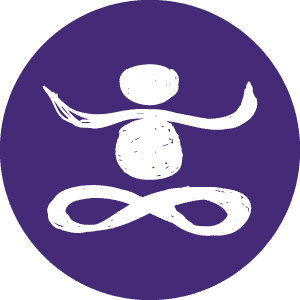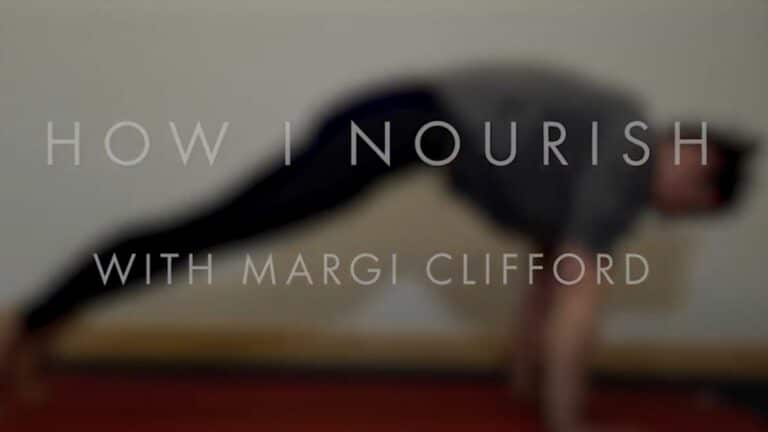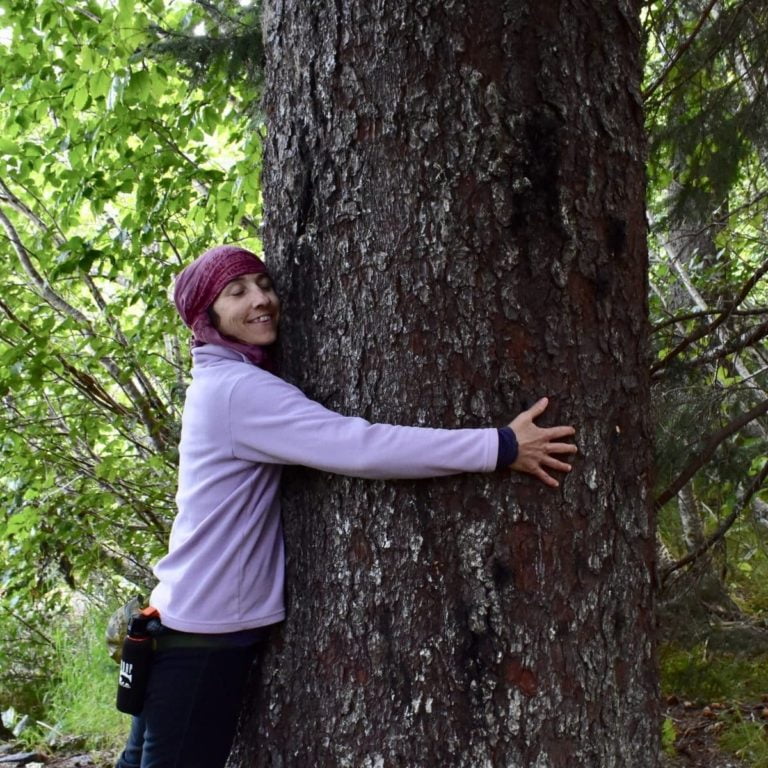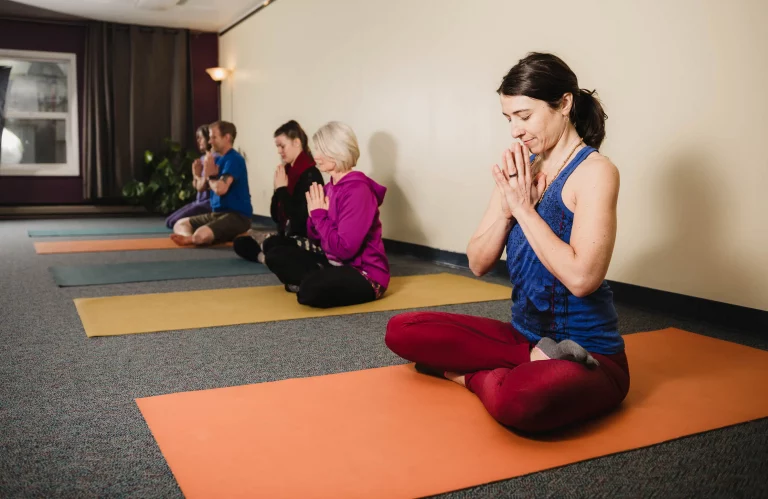I was asked this question recently: what is trauma-informed yoga? I’m a licensed counselor, yoga teacher and teacher trainer, and a certified yoga therapist with almost 20 years of experience. You’d think I’d know the answer to this question. The reporter who asked was looking for a sound bite of an answer from an expert and was referred to me.
Ninety minutes later, we were still dancing around the question and I still hadn’t given her the sound bite that she needed. Why not? Well… trauma does not fit very neatly into the spaces that we allow for it. In fact, the very nature of trauma is that it is disruptive, unruly, destructive, chaotic, and messy. Any efforts to try to understand and explain trauma must realize this.
Furthermore, yoga can be complicated too. It is an insight-based practice that allows us to be more present and aware of our interconnectedness. The Yoga Sutras (philosophical teachings) tell us that by doing this practice we can avoid future suffering. It allows healing to happen. Yoga can also be understood as “skillful action.” This is the first known written definition of the term.
If we consider then… trauma-informed yoga as skillful action that is aware of past experiences, particularly harmeful ones, we might think quite a bit more broadly about what this practice might look like.
Let me take a moment here to make sure that we have shared understanding of the terms related to trauma-informed yoga.
What is yoga?
I’ve already defined yoga as “skillful action” and as “an insight-based practice that allows us to be more present.” Additionally, it important for practitioners to understand that the postures that we are so familiar with are just one of the eight limbs of yoga. There are also moral principles rooted in non-violence; self-care, breathing, and sensory practices that prime the body and mind for the concentration, meditation, and full absorption that follow.
Hatha yoga is focused on balance. It is a “type” of yoga that focuses on the physical practices. “Ha” is sun and “tha” is moon in Sanskrit, the ancient language of yoga. Hatha yoga practices focus on balance in the body with a multitude of postures, breathing and sensory exercises that require both strength and flexibility.
Posture practice gives a body and all of its parts the opportunity to see what it is like to move forward and backward, side to side, and to turn. We “stand,” or perhaps more accurately “sit,” as the word asana which is commonly used to refer to the postures of yoga literally means “seat,” on one foot, two feet, on our hands, knees, shoulders, head, elbows, forearms… We also practice being very active and being very passive. In this way, we are able to see more clearly what wisdom (often by way of doubt and confusion) the body holds.
Our bodies hold the wisdom of our experience. Sometimes, we are not able to fully realize that wisdom at the time it is imparted. That may be because we are busy doing other things like surviving, working, raising families, healing, growing up, going to school. Yoga and the self-reflection that it encourages gives us a chance to extract that wisdom. The sutras tell us that when we do we not only taste the sweetness of life but can avoid future suffering as well.
You can learn more about the eight limbs of yoga in the attached video.
What is trauma?
As mental health clinicians, my colleagues and I are responsible for assessing, diagnosing, and developing treatment plans to help facilitate mental and emotional healing. This is often following traumatic experience(s). “Officially” traumatic experiences are ones that pose a direct or perceived threat of potentially lethal harm. This can be overtly physical, mental, and/or emotional. Click here to see the full diagnostic criteria from the National Institute of Health for Posttraumtic Stress Disorder as of this writing (note that diagnostic criteria are regularly revised.)
Most, if not all, people will have traumatic experiences over the course of their lives.
We sometimes distinguish between obvious Trauma (with a capital “T”) and less obvious trauma (with a lowercase “t”) to help clients understand the breadth of what is possible. I’m not sure that this is always helpful. There are certainly different degrees of threat, however, the impact has as much to do with a myriad of other variables as it does the event itself. It would be short-sighted (and not very trauma-informed) to assume to “rank” a traumatic experience as more or less impactful. In fact, doing so may be re-traumatizing.
People who are members of traditionally disempowered groups are likely to exhibit symptoms of trauma and more likely to experience additional trauma. That includes women, people of color, people living in conflict zones, people whose gender identity differs from that which they were assigned, people whose sexual orientation is other than hetero-normative, people with less common developmental, physical and cognitive abilities, and people with disadvantaged socio-economic status, among others.
Additionally, the effects of childhood trauma are well-known to persist into adulthood and seem to increase the likelihood of additional adversity throughout the lifespan. It matters at what stage in our development we are exposed to trauma. If you want to read more about adverse childhood experiences and outcomes, you can click here to learn more.
Besides the accidents, assaults, natural disasters, injuries, illnesses, deaths, and disappointments that can result in trauma, I think it is important to further elucidate the trauma inherent in a caste-based system, such as ours. In such systems, access to safe living conditions, including medical care, nutrition, agency over one’s body, and the freedom to pursue a lifestyle of one’s preference, is largely determined by the conditions of one’s birth. Not having access to safe living conditions such as these is certainly a mechanism for trauma.
Isabel Wilkerson’s groundbreaking book, Caste, clearly explains the problem.
Secondary and vicarious trauma
An additional note here that speaks to the interconnected nature of our experience. People who exhibit the symptoms of trauma may have been directly or indirectly involved. That is, people who have observed, read about, heard about, or otherwise know about traumatic events and experiences may also exhibit symptoms. This can be true for parents, friends, neighbors, and news junkies, as well as for professionals.
The compounded effects of repeated exposure to traumatized people and traumatic events, as may be experienced by first responders, healthcare providers, social workers, clergy, journalists, and others can be significant. This is especially true when the risk of such exposure is not recognized and steps are not taken to protect and support these professionals. Compassion fatigue and burnout are common in these professions and can be indicators of secondary or vicarious trauma.
Trauma-informed yoga teachers and therapists should be aware of inherent risk related to this kind of exposure.
How can we recognize trauma?
There are as many different manifestations of trauma as there are unique human experiences… however, there are enough similarities that we can start to recognize patterns. The list below includes some of the most common ways that humans respond to trauma. It is by no means exhaustive. It should also be noted that if you experience one (or more) of the symptoms listed, that doesn’t necessarily mean it’s a trauma response. A thoughtful assessment of both current symptoms and past experiences should help you determine what might be most supportive moving forward.
Here are some common symptoms:
- excessive fear / apprehension
- inability to focus
- insomnia / hypersomnia
- excessive tension, inability to relax
- irritability / anger / hyperreactivity
- depression
- excessive self-doubt / shame / guilt
- lethargy / anhedonia (lack of interest or pleasure in doing things)
- easily startled
- controlling behaviors / perfectionism
- self-destructive behaviors
- intrusive thoughts
- avoidant behaviors
- hopelessness
- pain, inflammation
- immune system changes: auto-immune conditions and/or poor immunity
How can we heal from trauma?
Healing carries with it the promise of unfettered movement. It implies that we can “get back” to how we were or what we used to do before we were injured. (I sometimes interchange the words trauma and injury and here mean the same thing by both.
This is actually quite complicated. The trajectory of our lives is constantly moving forward… while we are healing we are also aging. With age comes wisdom (or at least the potential for wisdom.) As we integrate past experience we have more information about the risks and benefits of a situation. To make a different choice after a trauma does not necessarily mean that you haven’t healed. In fact, a wise choice may be the very indication that healing is happening!
Many of my colleagues and I have been so impressed with the wisdom and compassion that can follow traumatic experiences that we have adopted the phrase “post-traumatic growth” to describe the phenomenon. Along those lines, I would encourage you to consider recognizing any/all of the symptoms listed above as part of a healing process.
Each person’s healing follows its path. All include aspects of physical, mental, and emotional health. All find some semblance of safety, agency, and connection, both to one’s narrative and to others.
Recognizing the stages of healing along with the layers or aspects of experience can help to orient both the traumatized person and those who aspire to support them. Knowing where you are is the first, essential, piece of information that you need when plotting a course. Mindfulness practice can help you develop this awareness.
Trauma-informed yoga
Trauma-informed yoga has grown out of awareness. Yoga professionals are increasingly aware of the vulnerability and courage that students and practitioners bring to the practice. We want to be part of the solution, not part of the problem.
Initially, trauma-informed yoga was focused on “big T” traumas. Trauma-informed yoga training encouraged teachers to be aware that certain movements, postures, and language could evoke traumatic memories and prompt symptoms. We tried to be less directive about expectations and more attuned to students’ subtle (and sometimes not so subtle) behaviors.
We also started to be much more mindful of inclusion and the harm that exclusion has and does cause. Adaptive yoga, plus-sized yoga, yoga for elders, yoga for veterans, yoga for cancer, yoga for kids, prenatal yoga, and a whole myriad of other specialized yoga classes have become part of the way that we practice.
Unfortunately, yoga, as we know it, is both a product of and continues to exist within a hierarchical social system. Please refer back to the section on “What is Trauma” and the reference to Isabel Wilkerson’s work if you’d like more explanation. Yoga, as recently as one generation ago, was practiced and taught almost exclusively by men.
The hatha yoga practices that were brought to the West in the last century were didactic by nature. There were instructions to be followed precisely. There was a right way to do things and a wrong way. In some styles, there is even an exact sequence of postures to “perform” and permission to take a drink of water, release a pose, breathe in, and breathe out is bestowed by an all-powerful teacher, guide, or guru (who knows better than you do what you need and when you need it.)
I believe that these systems intend to instill order, cultivate discipline, and develop connection, at best. At worst, they are disempowering and can be downright abusive. I will spare you here the long list of disgraced yoga teachers who have been guilty of abuse of power and sexual assault but rest assured, it is long. Power and the perception of power still seem to breed subjugation, loss of freedom, and, often further harm.
What makes a yoga teacher or class trauma-informed?
Trauma-informed yoga teachers, therapists, and practitioners should consider both the cultural and historical context that they are practicing within, and, their personal history.
Trauma-informed yoga teachers, therapists, and practitioners should be aware of their own trauma history, healing process, vulnerability, and ongoing opportunities for growth.
Trauma-informed yoga teachers, therapists, and practitioners should seek out mentorship, training, feedback, and growth opportunities whenever possible. The best will do so more ardently as they become more “experienced.” Licensing boards and credentialing bodies usually have related requirements and while these are not the only ways that someone might demonstrate their commitment, they can point you toward committed professionals.
Trauma-informed yoga teachers, therapists, and practitioners should also be able to anticipate, recognize, and respond to signs of compassion fatigue, burnout, and, megalomania in themselves.
We should be humble, inquisitive, and reflective.
We should listen carefully, look closely, and trust our students to find their way. We should express gratitude for the gift of presence, and encourage acceptance and love. Healing happens when we do.
The physiology of trauma and trauma-informed yoga
Ok, here is the “simple” answer that we’ve been seeking: move (and then don’t.)
It doesn’t matter initially, how or how much. What matters is that we move, and, that we rest.
When we experience a traumatic event, we’re shocked, no less dramatically than if a lightning bolt did the deed. Our bodies seize while our brain desperately tries to understand what is happening and what to do. Often, it can’t do more than just that. Bodies luckily, are equipped with safety mechanisms (including ones that help our brains to “look away” from what is too difficult to behold.) They can usually, eventually, get us out of the dangerous situation.
The problem that can persist is the separation between mind and body, and, unhelpful confusion between past and present. It can feel impossible to “move on” when the mind and body, each in their way, are still trying to sort out what happened.
To “reset” the rhythm between mind and body, past/present/future, movement and rest… we start with awareness. Notice that balance is inherent in each cycle of the breath. It includes movement in, rest, movement out, rest. Each time we notice, we begin again. Start there. Explore bigger, more intentional movements as your tolerance and curiosity allow, notice, and encourage the stillness after the movement.
Healing is happening.






